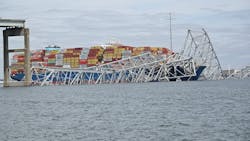How Maryland fleets are faring after the Baltimore bridge collapse
Baltimore’s Francis Scott Key Bridge collapse continues to impact nearby carriers’ operations, leaving local trucks with fewer loads and longer transportation times.
The Patapsco River span collapsed on March 26 after a container ship crashed into the bridge, sending part of the structure and construction vehicles into the waterway. The collapse also blocked maritime access for the nearby Port of Baltimore.
The accident has caused traffic congestion and delays for local trucking operations. The continued blockage of the Port of Baltimore also severely limits freight movement.
See also: How the Baltimore bridge collapse impacts trucking
“I don’t think anybody appreciates just how important that bridge was to so many segments of trucking,” Louis Campion, president and CEO of the Maryland Motor Truck Association, told FleetOwner. “According to the Federal Highway Administration, it averaged about 4,800 trucks per day that crossed it.”
Campion also cited recent data from the port administration that says that, to Maryland, the port’s constrained operations cost the state about $191 million every day.
Last week, Campion spoke with one of the association’s member organizations that runs between 10 and 20 trucks. “The first comment out of the owner’s mouth was: ‘I’m trying to make sure that I still have a business in three weeks.’ That’s the fear right now amongst a lot of industries that serve the Port of Baltimore.”
More FSK Bridge coverage from EBM
FleetOwner affiliates within Endeavor Business Media are covering the Francis Scott Key Bridge collapse from various business standpoints. Here is a roundup of coverage from the EBM, the largest B2B publisher in the U.S.
Port Baltimore Disrupts Equipment Supply: Imports of construction equipment and parts are being affected by the collapse of the Francis Scott Key Bridge in Baltimore
—Construction Equipment
Supply Chain Implications of Baltimore Bridge Collapse: The Port of Baltimore is the ninth biggest port for international cargo in the U.S.
—Material Handling & Logistics
President Biden to Visit Key Bridge Site Friday: President Joe Biden is scheduled to visit Baltimore on Friday to “on the ground look.”
—Roads & Bridges
Crews Work to Open Port Baltimore: Bridge cleanup could create a temporary channel and allow continued search efforts
—Roads & Bridges
After Francis Scott Key Bridge Collapse–What are Safety Implications?: ARTBA notes that about one in three bridges need replacement
—EHS Today
Timeline of Francis Scott Key Bridge Collapse: A minute-by-minute account of the collapse
—Firehouse
Local Marina Open 24/7 to Support Baltimore Bridge Collapse Responders: Anchor Bay East is located a mile away from the FSK Bridge collapse and is being used by workers for breaks and to fuel boats
—Firehouse
Divers Find Two Bodies in Truck Amid Tangled MD Bridge Debris: The remaining victims will be extricated via salvage operation
—Firehouse
NTSB Investigating Key Bridge Collapse: Structure was "fully up to code."
—Roads & Bridges
Key Bridge Collapse Leads to Long Commutes in Baltimore: I-695 is a major transportation artery
—Roads & Bridges
Port Blocked by Baltimore Bridge Collapse is Key Hub for US Shipping: The Port of Baltimore's vehicles terminals moved over 750,000 vehicles in 2022
—Industry Week
How the Baltimore bridge collapse impacts trucking: Trucking operations are forced to navigate travel restrictions around a major East Coast traffic area
—FleetOwner
Listen: Cargo Ship Collapses Baltimore Bridge, Sending 7 Vehicles into Water: The Maryland Transportation Authority Police dispatch and response to the Key Bridge Collapse
—Officer
Impacts on freight movement
The bridge collapse has impeded cargo access to the Port of Baltimore, slowing local freight movement.
“The port has still been busy for the last week because there was cargo at the terminals that had been delivered before the collapse,” Campion said. “There’s been a lot of truck activity just clearing out cargo that was already on terminal, but within a day diversion was happening to locations like Norfolk to New York to New Jersey to Philadelphia. I’m even hearing some diversion to Delaware.”
The collapse also significantly impacted local spot flatbed freight market data, as recent data from DAT Freight & Analytics show.
“Baltimore consistently ranks in the top 10 markets for spot flatbed freight in March,” Dean Croke, principal analyst for DAT, said. “Last week’s bridge collapse saw a 57% surge in spot flatbed loads moved from Baltimore and higher linehaul rates on critical lanes. The number of spot flatbed loads moved from Baltimore to Chicago increased by 117% compared to the previous week, and the average spot flatbed jumped 25 cents to $2.03 a mile.”
However, the collapse likely won’t have as significant an impact on national markets.
“From a macroeconomic point of view, the impact of the Port of Baltimore’s situation should be limited,” Allianz Trade told FleetOwner. “Container imports via the Port of Baltimore account for 2.1% of total U.S. port traffic. We therefore estimate that 1.5% of U.S. imports enter through the Port of Baltimore ... In addition, potential diversions of maritime flows to neighboring ports should further mitigate the effects of shortages and delivery delays.”
Detours in and around Baltimore
To reach the harbor for routes that would typically cross the Francis Scott Key bridge, trucks now have to take one of three alternative routes: the Fort McHenry Tunnel on I-895, the Baltimore Harbor Tunnel on I-95, or around the Baltimore beltway on I-695.
Both tunnels have clearance restrictions that may limit some trucks from these routes. The Baltimore Harbor Tunnel limits vehicles to 162 inches tall and 96 inches wide. The Fort McHenry Tunnel limits vehicles to 174 inches tall and 132 inches wide. Both tunnels also prohibit hauling hazardous materials, including propane gas and bulk gasoline.
Freight vehicles that cannot use the tunnels should use the longer route around the Baltimore beltway instead.
“There’s much longer transportation time having to take the alternate route,” Campion said. “Additionally, traffic congestion is much worse as a result of the many, many thousands of cars and trucks that traditionally would have used the Key Bridge.”
About 115 million vehicles cross the bridge each year. Now, they have to pass through one of the three alternative routes. Those alternatives are being pushed past their capacity, congesting roadways, and slowing local truck operations.
One of MMA’s members, Campion shared, saw significantly longer transit times in taking the beltway detour. “A particular route that they would take would have run them about two and a half hours, and it is running them 50% longer from a time standpoint to make that same delivery.”
Recovery efforts
“Until the shipping channel is open, there’s a choke point; it’s choking off economic activity,” Campion said. “It’s why there’s such a priority on trying to get the waterways open, because there is such a potential for extreme negative impact on these local businesses.”
Public officials are still working to recover bodies and debris from the Patapsco River to allow maritime access for the Port of Baltimore. Crews have already opened two temporary channels for smaller vessels and are working to open a third channel for larger vessels, according to ABC News. However, these channels will not help move much freight in the near future.
“There have been some modest openings, but those have really been more for emergency services associated with recovery efforts,” Campion said. “Those channels are not going to have anywhere near the berths that the port traditionally has had ... Right now, that is essentially still blockaded.”
Support for local carriers
Campion, on behalf of the Maryland Motor Truck Association, sent an open letter to the Maryland Department of Transportation asking for six regulatory waivers to support motor carriers.
Put broadly, the letter asks for:
- Extensions to permitted driver hours of service
- Exceptions to some operators’ electronic logging device requirements
- Relief from some International Registration Plan requirements
- Changes to motor fuel haulers’ route designations
- Financial assistance for local businesses
- Waivers for motor carriers without International Fuel Tax Agreement decals
The International Fuel Tax Agreement waiver has already been achieved, according to Campion.
“That has already been achieved, thanks to our comptroller’s office, who really acted very quickly on that,” Campion said. “We think we are going to get some of those other requests in the near future.”
MMTA also worked with the governor’s office and the Small Business Administration to help set up economic injury disaster loans so members could pursue financial assistance. On April 1, Baltimore opened two Business Recovery Centers to help business owners process disaster loan applications.
Maryland lawmakers are also working to pass legislation to provide economic relief grants to workers and small businesses impacted by the port’s closure, according to The Baltimore Sun.
“We’re optimistic that there may be some help to throw a life preserver to some of the businesses who might really be struggling through this,” Campion said.
About the Author
Jeremy Wolfe
Editor
Editor Jeremy Wolfe joined the FleetOwner team in February 2024. He graduated from the University of Wisconsin-Stevens Point with majors in English and Philosophy. He previously served as Editor for Endeavor Business Media's Water Group publications.

